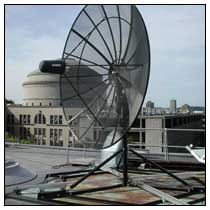Measurement of the Doppler spectrum of interstellar atomic hydrogen and the dynamics of the galactic rotation. A 2.5 meter computer-controlled alt-azimuth parabolic dish antenna, located on a roof of MIT, is used with a heterodyne measurement chain and digital correlator to observe the Doppler spectrum of the 21 cm hyperfine line of interstellar atomic hydrogen in various directions along the Milky Way. Features of the spiral-arm structure of the Galaxy are deduced from the measured radial velocities of the HI clouds in the galactic disc.
Lab Guide (PDF)

A 2.5 meter computer-controlled alt-azimuth parabolic dish antenna. (Image courtesy of Junior Lab staff.)
References
Ewen, H. I., and E. M. Purcell. "Observation of a Line in the Galactic Radio Spectrum." Nature 168 (1951): 356.
 Lerner, Rita G., and George L. Trigg. "Radio Astronomy." In Encyclopedia of Physics. Reading, MA: Addison-Wesley, 1981, pp. 41-42. ISBN: 9780201043136.
Lerner, Rita G., and George L. Trigg. "Radio Astronomy." In Encyclopedia of Physics. Reading, MA: Addison-Wesley, 1981, pp. 41-42. ISBN: 9780201043136.
Schlovsky, I. "Monochromatic Galactic Radio Waves." Chapter 4 in Cosmic Radio Waves. Cambridge, MA: Harvard University Press, 1960.
Mihalas, Dimitri, and James Binney. "Galactic Rotation and the Spiral Structure of Our Galaxy." Chapter 8 in Galactic Astronomy. San Francisco, CA: W.H. Freeman, 1968.
 Shu, Frank H. "Our Galaxy: The Milky Way System." Chapter 12 in The Physical Universe: An Introduction to Astronomy. Mill Valley, CA: University Science Books, 1982. ISBN: 9780935702057.
Shu, Frank H. "Our Galaxy: The Milky Way System." Chapter 12 in The Physical Universe: An Introduction to Astronomy. Mill Valley, CA: University Science Books, 1982. ISBN: 9780935702057.
This reference gives a clear description of the interpretation of 21cm spectra in terms of the rotation curve of the Galaxy.
Particle Data Group: Astrophysical Constants and Parameters ( PDF)
PDF)
Tuve, M. A., and S. Lundsager. "Velocity Structures in Hydrogen Profiles: A Sky Atlas of Neutral Hydrogen Emission." Carnegie Institution of Washington Publication, no. 630 (1973).
Selected Resources
NOAA Solar Position Calculator
Wikipedia Entry on the Milky Way Galaxy
Cambridge University Press Handbook of Space Astronomy and Astrophysics
Marshall Space Flight Center - Solar Research Page
UC San Diego Center for Astrophysics - Prof. Gene Smith's Milky Way Tutorial
Small Radio Telescope Engineering Resources
Haystack Observatory's SRT Web site - This is a very important site for students to investigate. Detailed block diagrams and schematics of the 21 cm receiver, mount and ground controller are available here.
